|
|
|
|
Late Entries to a Survey of Bestiaries
The staff of the Poison Pie Publishing House assembled a survey of one hundred bestiaries, posting an entry on their blog for each day from June 1, 2016 to September 8, 2016. When they were done, there were additional bestiaries that they did not want to omit entirely. This page lists latecomers to the survey added in 2020.
|
|
|
|
|
January 4, 2020
Alien Codex
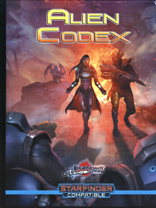 lead designer: Jason Nelson
lead designer: Jason Nelson
authors: Anthony Adam et al.
interior artists: Simon Aan et al.
cover artist: uncredited
publisher: Legendary Games
publication date: 2019
cover: hardcover
number of pages: 302
ISBN-10: 1-7092-0692-6
ISBN-13: 978-1-7092-0692-4
catalog number: LGP401AB025SF
description: This codex contains descriptions of over 50 species, over three dozen playable races and over 150 non-player characters. It is compatible with the Starfinder Role Playing Game.
Our featured entry from this bestiary is the erahthi psychic.
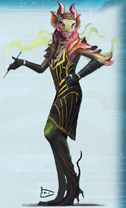 Born of the verdant and ancient forests covering the wood-aligned planet of Kir-Sharaat, the erahthi are at once both plantlike and elemental creatures. Erahthi are born from massive, translucent fruit grown from ancient miles-tall trees called Heartwoods and are engineered by life-bending alchemists and psychics before their birth to serve pre-determined castes of their society. Erahthi are masters of symbiotic technology, growing and animating plant material for nearly every purpose, from personal equipment to entire cities of living wood...
Born of the verdant and ancient forests covering the wood-aligned planet of Kir-Sharaat, the erahthi are at once both plantlike and elemental creatures. Erahthi are born from massive, translucent fruit grown from ancient miles-tall trees called Heartwoods and are engineered by life-bending alchemists and psychics before their birth to serve pre-determined castes of their society. Erahthi are masters of symbiotic technology, growing and animating plant material for nearly every purpose, from personal equipment to entire cities of living wood...
Society: Erahthi society is a rigid system of castes, with every member of the species grown for a specific role. An erahthi's physical body is grown in a massive, translucent fruit that grows on one of the miles-tall Heartwood trees of Kir-Sharaat. Nascent erahthi are tended by specialized castes of farmers who ensure each body develops as required. When an erahthi body is only a seedling, divinations predetermine what caste the erahthi will be best suited for; this defines the methods used to bring the body to full maturation. Once a body is mature, it is inhabited by a soul drawn from the aetheric currents by the Heartwood tree; this is considered the "birth" of an erahthi individual. Despite the body being fully formed at this birth, erahthi still require several years to mentally and physically mature and become accustomed to their form and the caste they were born into. A newborn erahthi is usually half of the height and weight of a fully-matured erahthi, and this transition to adulthood takes around 40 years to complete. Typical erahthi live for more than 200 years. The erahthi reproductive cycle means that they do not have gender in the same way as most other species and are incapable of reproduction outside of Kir-Sharaat. Some erahthi who explore beyond their home world often take on the customs of other species and may choose to present one or more genders based on personal preference...
Psychic ability is common among the erahthi, the wood-aligned elemental beings who inhabit the forest world of Kir-Sharaat. Those erahthi psychics who seek adventure beyond their homeworld are often referred to as "heartreaders", as their ability to divine emotion seems to give them the ability to read the truest desires of the heart. In reality, it is the heartreader's skill with enchantment that makes it seem so; victims believe they were following their own heart when they were in truth serving the erahthi's agenda instead.
Despite this power, most erahthi heartreaders do not manipulate those around them for personal gain. Many seek knowledge of new places and cultures, having little or no experience off their homeworld. Heartreaders merely find it expeditious to ensure conversations lead where the they want them to lead, rather than trusting to chance. Predictably, this approach is often met with hostility, despite the fact that the erahthi intended little deliberate harm.
|
|
|
|
|
February 1, 2020
Fearsome Creatures of the Lumberwoods with a Few Desert and Mountains Beasts
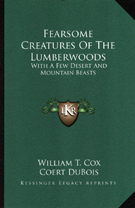 author: William Thomas Cox
author: William Thomas Cox
interior artist: Coert du Bois
original publisher: Judd & Detweiler, Inc.
reprint publisher: Kessinger Publishing, LLC
publication date: 1910
cover: softcover
number of pages: 47
ISBN-10: 1-163-07588-4
ISBN-13: 978-1-163-07588-3
description: This bestiary describes 20 creatures found in the wilds of North America during the early twentieth century.
Our featured entry from this bestiary is the squonk (Lacrimacorpus dissolvens).
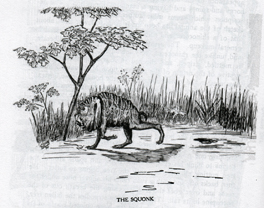 The range of the squonk is very limited. Few people outside of Pennsylvania have ever heard of the quaint beast, which is said to be fairly common in the hemlock forests of that State. The squonk is of a very retiring disposition, generally traveling about at twilight and dusk. Because of its misfitting. skin, which is covered with warts and moles, it is always unhappy; in fact it is said, by people who are best able to judge, to be the most morbid of beasts. Hunters who are good at tracking are able to follow a squonk by its tear-stained trail, for the animal weeps constantly. When cornered and escape seems impossible, or when surprised and frightened, it may even dissolve itself in tears. Squonk hunters are most successful on frosty moonlight nights, when tears are shed slowly and the animal dislikes moving about; it may then be heard weeping under the boughs of dark hemlock trees. Mr. J. P. Wentling, formerly of Pennsylvania, but now at St. Anthony Park, Minnesota, had a disappointing experience with a squonk near Mont Alto. He made a clever capture by mimicking the squonk and inducing it to hop into a sack, in which he was carrying it home, when suddenly the burden lightened and the weeping ceased. Wentlingunslung the sack and looked in. There was nothing but tears and bubbles.
The range of the squonk is very limited. Few people outside of Pennsylvania have ever heard of the quaint beast, which is said to be fairly common in the hemlock forests of that State. The squonk is of a very retiring disposition, generally traveling about at twilight and dusk. Because of its misfitting. skin, which is covered with warts and moles, it is always unhappy; in fact it is said, by people who are best able to judge, to be the most morbid of beasts. Hunters who are good at tracking are able to follow a squonk by its tear-stained trail, for the animal weeps constantly. When cornered and escape seems impossible, or when surprised and frightened, it may even dissolve itself in tears. Squonk hunters are most successful on frosty moonlight nights, when tears are shed slowly and the animal dislikes moving about; it may then be heard weeping under the boughs of dark hemlock trees. Mr. J. P. Wentling, formerly of Pennsylvania, but now at St. Anthony Park, Minnesota, had a disappointing experience with a squonk near Mont Alto. He made a clever capture by mimicking the squonk and inducing it to hop into a sack, in which he was carrying it home, when suddenly the burden lightened and the weeping ceased. Wentlingunslung the sack and looked in. There was nothing but tears and bubbles.
The esteemed squonk has also been celebrated in song, as evidenced by the following lyrics taken from the Steely Dan song, Any Major Dude, from the album Pretzel Logic (1974).
I never seen you looking so bad my funky one
You tell me that your superfine mind has come undone
Any major dude with half a heart surely will tell you my friend
Any minor world that breaks apart falls together again
When the demon is at your door
In the morning it won't be there no more
Any major dude will tell you
Have you ever seen a squonk's tears? Well, look at mine
The people on the street have all seen better times
Any major dude with half a heart surely will tell you my friend
Any minor world that breaks apart falls together again
When the demon is at your door
In the morning it won't be there no more
Any major dude will tell you
I can tell you all I know, the where to go, the what to do
You can try to run but you can't hide from what's inside of you
Any major dude with half a heart surely will tell you my friend
Any minor world that breaks apart falls together again
When the demon is at your door
In the morning it won't be there no more
Any major dude will tell you
|
|
|
|
|
March 7, 2020
The Official Godzilla Compendium
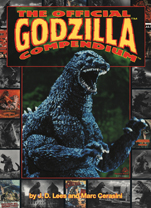 authors: J.D. Lees & Marc Cerasini
authors: J.D. Lees & Marc Cerasini
interior artist: Arthur Adams
cover design: Susan Lovelace
publisher: Random House
publication date: 1998
cover: softcover
number of pages: 144
ISBN-10: 0-679-88822-5
ISBN-13: 978-0-679-88822-2
Library of Congress Catalog number: 97-75898
description: This book reviews the twenty-two Godzilla movies released by the date of publishing and, of relevance to this survey, contains a section titled, "Profiles of the Monsters", which describes with text and illustrations twenty-nine monsters, a few with multiple forms.
Our featured entry from this bestiary is Gigan.
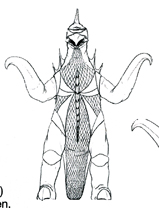 A fusion of flesh and technology, Gigan hails from the Nebula M Spacehunter. Evil, cockroach-like aliens sent this cyborg monster to Earth on a mission, with King Ghidorah, to destroy human civilization and thus pave the way for the installation of a new, alien civilization and "perfect peace."
A fusion of flesh and technology, Gigan hails from the Nebula M Spacehunter. Evil, cockroach-like aliens sent this cyborg monster to Earth on a mission, with King Ghidorah, to destroy human civilization and thus pave the way for the installation of a new, alien civilization and "perfect peace."
Gigan set out on its spree of destruction with evident glee, toppling towers, smashing ships, and slicing and dicing its way through downtown Tokyo. Only the intervention of Godzilla and Anguirus could slow this demon of demolition.
Gigan has a distinctive, rasping cry and uses powerful blows from its hooklike hammer claws to demolish any manmade structure blocking its path. It boasts a cranial horn, scythe-clawed feet, and three membranous dorsal sails, on which it flies. Gigan delights in attacking from the air, dive-bombing its opponents and gashing them with the buzzsaw cutter in its belly
Gigan also sports a tooth-lined, hooked beak below a single wine-red, visorlike eye. Publicity stills show Gigan firing a laser beam from its forehead, but this power has never been displayed during its screen appearances. And yet, despite its formidable armament, Gigan's inherent cowardice may be its Achilles heel. The cyborg is happy to attack an opponent who is dazed or whose back is turned, but it will just as quickly flee, even abandoning an ally if the tide of battle turns against them.
Since Gigan's partnership with King Ghidorah was foiled by Godzilla and Anguirus, and its subsequent team-up with Megalon was also a failure, the virulent cyborg no doubt still lurks in space awaiting another chance to wreak havoc on the Earth.
|
|
|
|
|
April 4, 2020
Bestiary of Krynn
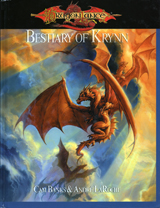 authors: Cam Banks & André LaRoche
authors: Cam Banks & André LaRoche
interior artists: Omar Dogan et al.
cover artist: Jeff Easley
publisher: Sovereign Press
publication date: 2004
cover: hardcover
number of pages: 160
ISBN-10: 1-931567-13-1
ISBN-13: 978-1-931567-13-8
Catalog number: SVP-4801
description: This bestiary contains descriptions of 75 creatures suitable for the Dragon Lance campaign setting. It is compatible with the d20 Role Playing Game.
Our featured entry from this bestiary is the wyndlass.
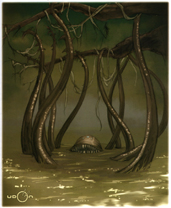 This creature looks like a foul brown-black octopus with ten barbed tentacles. Above its tentacles are three eyes that glow a dim blue. It surges up from a pit of quicksand, tentacles flailing.
This creature looks like a foul brown-black octopus with ten barbed tentacles. Above its tentacles are three eyes that glow a dim blue. It surges up from a pit of quicksand, tentacles flailing.
The wyndlass is a tentacled honor that makes its home in dismal swamps and forested wetlands. Its voracious appetite drives it to consume other animals in large quantities, and it has been known to strike at unwary travellers and adventurers who do not see it until it is too late.
The wyndlass resembles nothing less than a giant spiky octopus or squid with three glowing blue eves. 3 Its natural color is a muddy brown. but it can camouflage itself to some degree to match its environment. A wyndlass forms a pit by softening the earth around it and lurks within, waiting for its prey to wander by. Carcasses and remains are kept at the bottom of this quicksand, so as not to alert other animals of the immediate danger. Once the local area's game has been reduced sufficiently by the wyndlass, it hauls itself out of the pit and travels several miles to a new location.
Wyndlasses grow as long as 20 to 30 feet in length and weigh over a ton. They are thought to be mutated relatives of the giant squid that have adapted to life on land, very possibly by some wizard's bold experiments or the passage of the Graygem. A more sinister theory is that they are
Zeboim's children, vicious predators altered by the storm goddess to wreak havoc on the beloved of Habbakuk and Chislev.
Wyndlasses do not speak, but are intelligent enough to understand Common.
|
|
|
|
|
May 2, 2020
Ultimate Bestiary: Revenge of the Horde
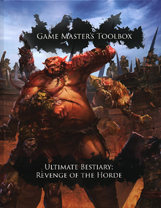 author: Ralph Stickley
author: Ralph Stickley
interior artists: Konrad Krogull & Takashi Tan
cover artist: uncredited
publisher: Nord Games
publication date: 2017
cover: hardcover
number of pages: 196
ISBN-10: 1-946669-01-6
ISBN-13: 978-1-946669-01-8
description: This bestiary contains descriptions of numerous members of varying levels for nine different monstrous races, including bugbears, gnolls, goblins, hobgoblins, kobolds, ogres, okiti, orcs and trolls. It is intended for a fantsy campaign setting. It is compatible with the fifth edition of Dungeons & Dragons.
Our featured entry from this bestiary is the okiti poisoner.
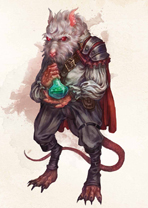 Okiti, ratmen, bilge rats, or simply bilgers, are a surprisingly populous race of humanoid rodents. Their origins presumably
lie across the sea as they can be found in great numbers in any decently sized port if one looks hard enough, though they are
experts at evading attention.
Okiti, ratmen, bilge rats, or simply bilgers, are a surprisingly populous race of humanoid rodents. Their origins presumably
lie across the sea as they can be found in great numbers in any decently sized port if one looks hard enough, though they are
experts at evading attention.
Resembling large, bipedal rats, okiti stand between three and four feet tall, with wiry limbs and a long, thin tail. Some individuals are able to control this tail to the extent of holding a torch or similar object, but stories of okiti picking pockets, swinging from rafters, or sword-fighting on the crossbeam of a sinking ship using their tails are almost certainly embellishments. Short lived for humanoids, okiti start to suffer the effects of old age at around twenty, and most will not see twenty-five.
Okiti give birth to large litters of young, usually between seven and fourteen, which are about as developed as human babies. The young mature quickly, and are considered adults by the age of two. Until that time, they are raised communally, with each member of the colony contributing their own skills to their education as and when they have time. While somewhat chaotic, this does raise okiti with a rounded set of skills, and a strong sense of community.
In contrast to their natural stealthiness, okiti tend to dress in paradoxically garish clothing, favoring swathes of bright, rich fabrics decorated with trinkets. It would seem okiti take pride in being able to escape notice despite this handicap, as well as it being a way to show off their loot...
Those who think okiti nothing more than a charming nuisance need only open a book of medical histories to see their folly. Firebrow, Rat-Bite Fever, Knotgut, Yellow Horror, Rot Bones, The Red Death (which commoners call 'dead by dinner'), The Four Day Shakes; all of these and more see their first victim taken in a city with a known okiti problem.
--Kozel Encona, A Primer to the Healing Arts
|
|
|
|
|
June 6, 2020
Oathbound Bestiary
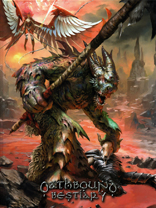 lead designer: David Tomczyk
lead designer: David Tomczyk
interior artists: Todd Morasch et al.
cover artist: Simon Dominic
publisher: Epidemic Books
publication date: 2018
cover: hardcover
number of pages: 262
ISBN-10: 0-9844417-9-4
ISBN-13: 978-0-9844417-9-2
description: This bestiary contains descriptions of over 200 varieties of monsters. It is intended for the Oathbound campaign setting. It is compatible with the first edition of Pathfinder.
Our featured entry from this bestiary is the dendrite.
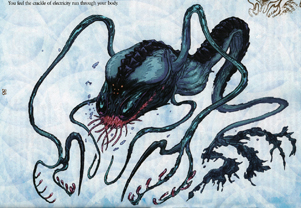 Dendrites are creatures unique to the sullen Sea of Ink in Eclipse. These bizarre creatures are approximately the size of a large adult shark, but would never be mistaken for one. They have a large mouth, an odd, egg-shaped central body, a whip-like tail, and a mass of grasping kelp-like tentacles which they use to entangle their victims. Unlike other creatures, dendrites do not appear to be intelligent on their own, and solitary
individuals have been witnessed performing quite erratic behavior-even reportedly swimming directly into rocky obstructions as though they were blind. Dendrites make no effort to communicate to other beings, although observation has suggested that they are able to communicate quite well with each other by means of their tentacles and tails. Dendrites do have an unusually high amount of nerve matter running throughout their bodies, but nothing which would normally resemble a brain. It is surmised that each one serves as a single node in a larger intelligence, though no one seems to be able to agree upon what this intelligence serves or where it would manifest.
Dendrites are creatures unique to the sullen Sea of Ink in Eclipse. These bizarre creatures are approximately the size of a large adult shark, but would never be mistaken for one. They have a large mouth, an odd, egg-shaped central body, a whip-like tail, and a mass of grasping kelp-like tentacles which they use to entangle their victims. Unlike other creatures, dendrites do not appear to be intelligent on their own, and solitary
individuals have been witnessed performing quite erratic behavior-even reportedly swimming directly into rocky obstructions as though they were blind. Dendrites make no effort to communicate to other beings, although observation has suggested that they are able to communicate quite well with each other by means of their tentacles and tails. Dendrites do have an unusually high amount of nerve matter running throughout their bodies, but nothing which would normally resemble a brain. It is surmised that each one serves as a single node in a larger intelligence, though no one seems to be able to agree upon what this intelligence serves or where it would manifest.
Individually, dendrites are unpredictable and are quite capable of attacking at random, seemingly with great malice. However, in groups, they appear to obey or operate as part of a hive mind, moving and striking as one with grace and ample speed. Their tentacles envelop their prey in a web of inescapable strands, and the victims can then be absorbed into the body of the dendrite, digested whole by enzymes and chemicals. The dendrite's whip-like tail is used to strike and stun larger prey, and is often its first defense if attacked. Also, one must beware the highly electric nature of these beasts, which can stun or even kill prey from a distance. When larger food is not available, the dendrite will simply swim into a school of fish, set off its charge, and then go about devouring the resulting floating meat sticks at its leisure, Due mainly to this ability, plus the oddity of their shape and the strangeness of their hive-like mind, the dendrites are well-known among the land-dwellers of Eclipse, even though most have never seen one.
Relatively little is understood about dendrites, even if they have lived in Eclipse now for thousands upon thousands of years. Their origin is unknown-they may have simply started out as smaller parasites and evolved into something more. Over time they have certainly become more and more prevalent, and today, common wisdom states that any swim in the Sea of Ink is a death wish. Dendrites do not attack ships, but will attack any creatures swimming in the water smaller than themselves. Their diet mostly consists of fish but they are not averse to eating higher life forms if the opportunity presents itself. Few survive dendrite attacks without some escape plan, as dendrites tend to swarm to areas where they sense one of their kind + danger. The Blackwater company has tried to fish these predators in the past, but has found little use for them, and their rubbery bodies are widely considered inedible.
|
|
|
|
|
July 4, 2020
Splinter Ugly Things
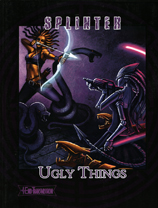 line developer: Devon Oratz
line developer: Devon Oratz
lead writers: Mikaela Barree & Devon Oratz
interior artists: Andres Canals et al.
cover artist: Jes Cole
publisher: End Transmission Games
publication date: 2016
cover: softcover
number of pages: 240
ISBN-10: 0-9970993-0-5
ISBN-13: 978-0-9970993-0-0
description: This bestiary contains descriptions of over 160 varieties of creatures. It is intended for the Splinter roleplaying game.
Our featured entry from this bestiary is the nameless thing.
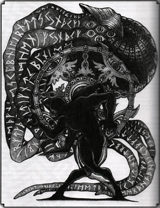 An ink-black, vaguely humanoid figure, equal parts shadow and terror. Its heavily muscled frame sports six limbs, then two, then five ... its impossible shape contorting in incomprehensible ways as it moves. Nameless things are unknown and unknowable. Left without a name when the neomonte created The Realm, the Nameless Things cannot exist - yet they do. Nameless things keep company with Daemons, which seem to be immune to their self-censoring effect. There is no way of knowing to what extent the Nameless Things are active within the realm: they could literally walk into Metropol's main headquarters and no one would remember. Perhaps they are rare and dangerous, or perhaps they are everywhere. Perhaps they are warring with the Bloodlines, or perhaps they have already won.
An ink-black, vaguely humanoid figure, equal parts shadow and terror. Its heavily muscled frame sports six limbs, then two, then five ... its impossible shape contorting in incomprehensible ways as it moves. Nameless things are unknown and unknowable. Left without a name when the neomonte created The Realm, the Nameless Things cannot exist - yet they do. Nameless things keep company with Daemons, which seem to be immune to their self-censoring effect. There is no way of knowing to what extent the Nameless Things are active within the realm: they could literally walk into Metropol's main headquarters and no one would remember. Perhaps they are rare and dangerous, or perhaps they are everywhere. Perhaps they are warring with the Bloodlines, or perhaps they have already won.
|
|
|
|
|
August 1, 2020
Star Wars Creatures Big & Small: Galactic Basic Edition
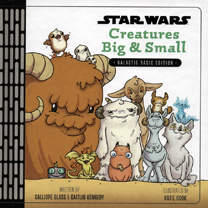 authors: Calliope Glass & Caitlin Kennedy
authors: Calliope Glass & Caitlin Kennedy
interior artist: Katie Cook
cover artist: Katie Cook
publisher: Disney Lucasfilm Press
publication date: 2019
cover: hardcover
number of pages: 48
ISBN-10: 1-368-05082-4
ISBN-13: 978-136805082-1
description: This bestiary contains descriptions of thirty creatures from the Star Wars universe. It is intended for all ages.
Our featured entries from this bestiary are the tauntaun and the wampa.
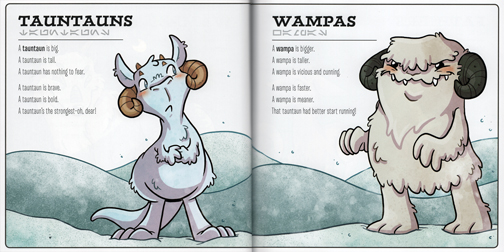
Tauntauns
A tauntaun is big.
A tauntaun is tall.
A tauntaun has nothing to fear.
A tauntaun is brave.
A tauntaun is bold.
A tauntaun's the strongest-oh dear!
Wampas
A wampa is bigger.
A wampa is taller.
A wampa is vicious and cunning.
A wampa is faster.
A wampa is meaner.
That tauntaun had better start running!
|
|
|
|
|
September 5, 2020
Numenéra: Into the Deep
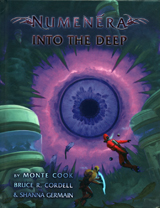 author: Bruce R. Cordell
author: Bruce R. Cordell
interior artists: Jacob Atienza et al.
cover artist: Kieran Yanner
publisher: Monte Cook Games
publication date: 2016
cover: hardcover
number of pages: 160
ISBN-10: 1-939979-45-5
ISBN-13: 978-1-939979-45-2
Catalog number: MCG082
description: This book is a supplement to the Numenéra role playing game, containing descriptions of locations and rules relevant to underwater campaigns. Pertinent to this survey, part four of the book is a bestiary with descriptions of 21 marine creatures.
Our featured entry from this bestiary is the octopus.
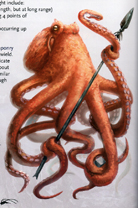 If the seas have a ruler, it is the octopus. Their billion-year empire spans the entirety of all seas, and their queen rules over all of it. They are, however, xenophobic and aloof, preferring to keep to themselves. Thus, many people call them the "quiet empire."
If the seas have a ruler, it is the octopus. Their billion-year empire spans the entirety of all seas, and their queen rules over all of it. They are, however, xenophobic and aloof, preferring to keep to themselves. Thus, many people call them the "quiet empire."
Octopuses vary in size, color, and, to some degree, shape. For the most part, they all have eight extremely flexible limbs, a surprisingly malleable body, two sophisticated eyes, and a beaklike mouth. They can change their color and, to a large extent, their shape to
appear as a rock, a fish, or some other creature. They perceive not just with their eyes but, in a limited way, with all their skin. They think not only with the brain in their head but also with the distributed neural network that runs throughout their limbs.
Octopuses are extremely intelligent, often possessing mental powers a human would deem supernatural. Thanks to their advancement in various sciences, they are also immortal.
|
|
|
|
|
October 3, 2020
Numenéra: Into the Outside
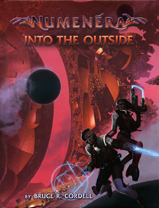 author: Bruce R. Cordell
author: Bruce R. Cordell
interior artists: Jacob Atienza et al.
cover artist: Kieran Yanner
publisher: Monte Cook Games
publication date: 2017
cover: hardcover
number of pages: 160
ISBN-10: 1-939979-47-1
ISBN-13: 978-1-939979-47-6
Catalog number: MCG082
description: This book is a supplement to the Numenéra role playing game, containing descriptions of locations and rules relevant to transdimensional campaigns. Pertinent to this survey, part five of the book is a bestiary with descriptions of 20 extraplanar creatures.
Our featured entry from this bestiary is the oroban.
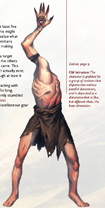 Orobans are wretched abhumans who have only a single arm and clawed hand that also serves as their face. They constantly murmur and mutter, which might be a language, though, if so, it is one that communicates only concepts of hunger, hunting, and threat. Orobans are few in number and usually live alone, but that weakness is compensated for by a knack they've learned for drawing parallel versions of themselves out of nearby dimensions at need. Orobans are divisive enough that they soon turn on even versions of themselves. This is why a lone oroban's crude domicile is often decorated with several corpses of itself. But more than they hate themselves, they hate other creatures.
Orobans are wretched abhumans who have only a single arm and clawed hand that also serves as their face. They constantly murmur and mutter, which might be a language, though, if so, it is one that communicates only concepts of hunger, hunting, and threat. Orobans are few in number and usually live alone, but that weakness is compensated for by a knack they've learned for drawing parallel versions of themselves out of nearby dimensions at need. Orobans are divisive enough that they soon turn on even versions of themselves. This is why a lone oroban's crude domicile is often decorated with several corpses of itself. But more than they hate themselves, they hate other creatures.
|
|
|
|
|
November 7, 2020
Numenéra: Into the Night
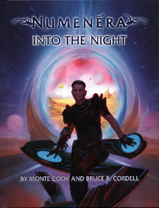 authors: Monte Cook & Bruce R. Cordell
authors: Monte Cook & Bruce R. Cordell
interior artists: Jacob Atienza et al.
cover artist: Kieran Yanner
publisher: Monte Cook Games
publication date: 2015
cover: hardcover
number of pages: 160
ISBN-10: 1-939979-40-4
ISBN-13: 978-1-939979-40-7
Catalog number: MCG071
description: This book is a supplement to the Numenéra role playing game, containing descriptions of locations and rules relevant to space campaigns. Pertinent to this survey, part four of the book is a bestiary with descriptions of 16 interstellar creatures.
Our featured entry from this bestiary is the mujidavar.
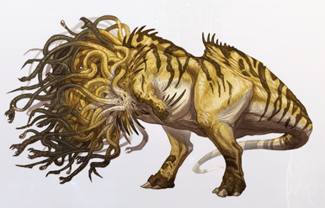 The universe is an interesting place. How else can a location of such incredible beauty—the Fields of Dore—also be home to a predatory terror with such a hideous countenance?
The universe is an interesting place. How else can a location of such incredible beauty—the Fields of Dore—also be home to a predatory terror with such a hideous countenance?
Mujidavari are bipedal, scaly monstrosities with long tails. Where one might expect a head, a mujidavar has a squirming mass of tendrils and tiny mouths. Some of the tendrils end in bony blades, some in bulbous eyes, and a few in still more tiny mouths.
|
|
|
|
|
December 5, 2020
Beasts & Behemoths: A Young Adventurer's Guide
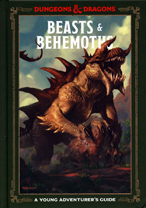 author: Jim Zub with Stacy King and Andrew Wheeler
author: Jim Zub with Stacy King and Andrew Wheeler
interior artists: Conceptopolis, LLC.
cover artist: Conceptopolis, LLC.
publisher: Ten Speed Press
publication date: 2020
cover: hardcover
number of pages: 106
ISBN-10: 1-9848-5878-5
ISBN-13: 978-1-9848-5878-8
description: This book contains 39 creatures for a classical fantasy-based campaign. This book is compatible with the Dungeons and Dragons Role Playing Game.
Our featured entry from this bestiary is the legendary demi-lich, Acererak.
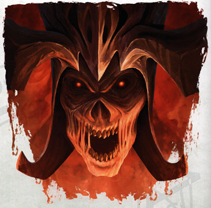 Becoming a demilich is not always a bitter end for a lich. When made as a conscious choice, it can be the next step in a dark evolution, freeing the spellcaster from the last restrictions of their physical form while retaining a spark of their original self. Acererak is one of the few who has succeeded in harnessing this transformation for their own evil ends.
Becoming a demilich is not always a bitter end for a lich. When made as a conscious choice, it can be the next step in a dark evolution, freeing the spellcaster from the last restrictions of their physical form while retaining a spark of their original self. Acererak is one of the few who has succeeded in harnessing this transformation for their own evil ends.
A powerful wizard and occult explorer, Acererak abandoned his physical form to travel through other planes of existence. He collects arcane artifacts and locks them away in trap-laden tombs. These elaborate dungeons are intended to lure powerful adventurers with the promise of great rewards. Most often, these heroes wind up failing in horrible ways, thanks to the devious devices and malicious monsters they encounter. Acererak then traps their souls in his phylactery, fueling his magical power.
Acererak's legend has inspired others to follow a similar path, though not always with success. The demilich has little interest in apprentices. His focus is on taunting the adventurers who dare enter his violent vaults. In time, he intends to evolve further, into an even more powerful and terrifying archlich form. Whether he will be successful in this dark endeavor remains to be seen.
|
|
|
|
|
Continue to 2021 entries.
|
|
|
|
|
|
|
|

